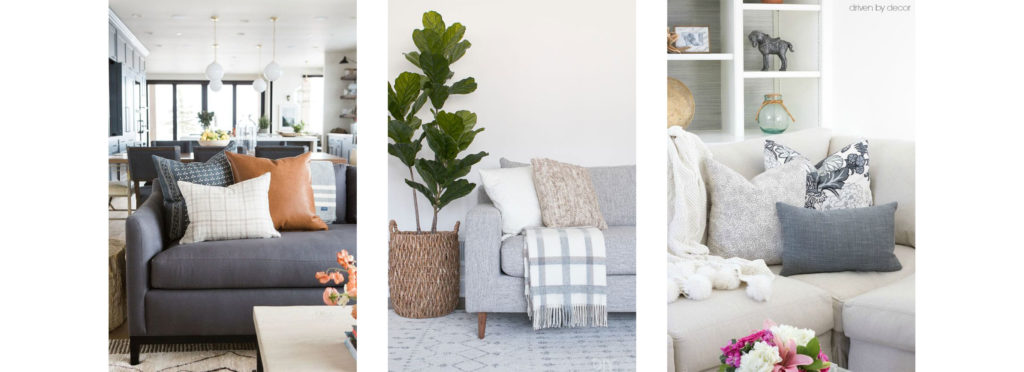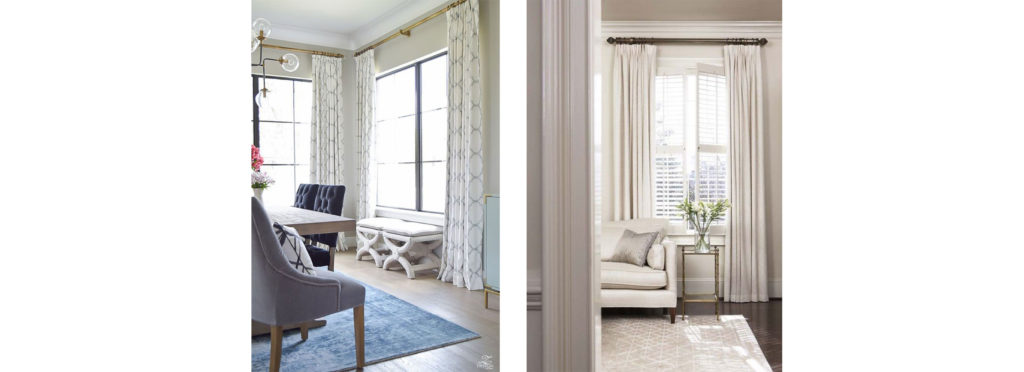We’ve noticed that our clients frequently ask a lot of the same questions about the placement and spacing of decor, lights, and drapes, and we have the answers! So we’ve decided to compile these FAQs into a helpful list of go-to design tips that we’d like to see implemented in all of our clients’ homes. Take a look!
RUGS
Rugs can be used to define a space and pull a room together, and they’re an easy way to promote the design style of your home. However, placing your rug correctly in the room can really make or break your space.
For example, in the living room, rugs should always sit under the front legs of your sofa and chairs, in order to tie the space together. Far too often, we see rugs sitting out in front of the sofa, which gives the room a disconnected feel. Ground that space!
In addition, dining room rugs should be large enough that the chairs can still sit on the rug when they’re pushed back from the table. You don’t want to fall off of the rug as you scoot your chair back! And in the bedroom, rugs should sit under the bed, with at least 8” between the nightstand and the edge of the rug, and at least a foot of rug showing on each side of the bed, and at the foot.

PILLOWS & THROWS
Pillows, pillows, pillows! Another great way to showcase your design style, pillows and can add dimension and texture to any room. However, we still have some guidelines to follow to make sure that your pillows look the best they can!
We recommend grouping your pillows in odd numbers, or add a throw blanket to an even-numbered group of pillows to throw off the symmetry. It’s also a good idea to vary the sizes and textures of your pillows and throws. This provides some visual interest and makes the room feel more inviting.

WALL DECOR
If a piece of artwork is hung too low or too high, it can throw the whole room off balance. Hang artwork with the center of the piece sitting at about eye level, or a tiny bit lower (usually between 58-62” off the floor). Gallery walls and sets of artwork should have an even amount of space between each item (preferably about 3”). If you get too funky with the spacing of your gallery wall, it can look a little messy.

ACCESSORIES
Accessories are an easy way to add a touch of your personality to any space. For coffee tables, ground your smaller accessories with a tray or large book. And on your bookshelves, we recommend grouping items of different sizes, shapes, and textures into odd-numbered clusters.
Another good thing to note: When placing accessories on your shelves, don’t feel the need to fill every space. Leave some breathing room in between. And don’t forget to place plants & flowers (fake is ok too!) in each room to bring some life to the space!

LIGHTING
Some of our most common questions have to do with the proper height for light fixtures in the kitchen and dining room. Dining room pendants should hang about 33” above the top of the table and kitchen island pendants should hang about 30” above the countertop.

DRAPES
Properly-hung drapes can provide the perfect finishing touch to any space. We love to hang our curtain rods close to the ceiling, rather than just above the window, to create the illusion of higher ceilings. But most importantly, the bottom of your drapery panels should hang just above the floor (1/8-1/4”). Any higher and they’ll feel too short!

BONUS TIP
This one’s a little hard to categorize, so we’ll call it a bonus. When placing your living room furniture, always allow about 15″ between the coffee table and the front of the sofa. Your shins will thank you!
We hope you find these tips useful! If you have any other questions, or would like to schedule a consultation, please feel free to contact us here.
Happy designing!
Xoxo,

Photo sources: 1 // 2 // 3 // 4 // 5 // 6 // 7 // 8 // 9 // 10 // 11 // 12 // 13 // 14 // 15 // 16 // 17

